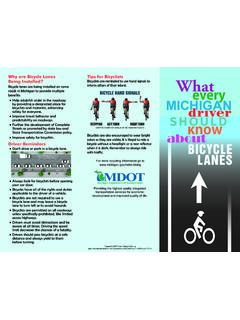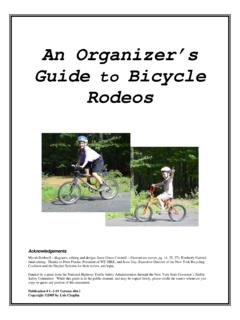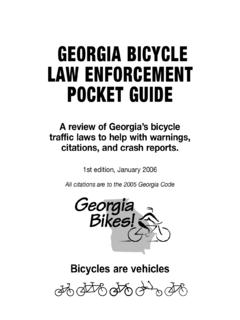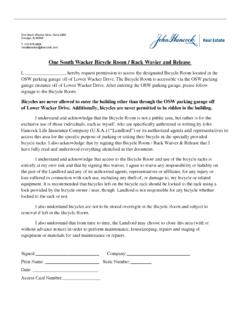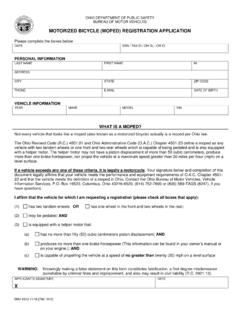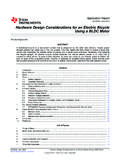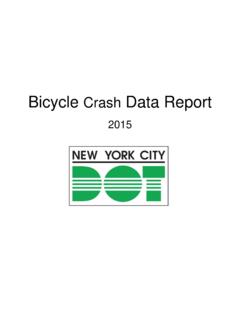Transcription of Where Ideas Connect UTAH! BICYCLE-RELATED …
1 BICYCLE-RELATED UTAH CODE (TITLE 41, CHAPTER 6). U T A H ! W h e r e I d e a s C o n n e c t Utah bicycle Laws Summary This list is a plain-language summary of the laws that apply to bicyclists and is provided for general information only. The actual wording of these laws, and additional laws, may be found in the referenced sections Title 41, Chapter 6 of the Utah Code, available online at under Laws/Constitution. A bicycle means every device propelled by human power upon which any person may ride, having two tandem wheels, except scooters and similar devices (41-6-1). Your bicycle is considered a vehicle and you have the same rights and are subject to the same provisions as the operator of any other vehicle (41-6-84(1)). This includes obeying traffic signals (41-6-24), stop and yield signs ( ), and all other official traffic control devices (41-6-23). The following paragraphs point out those laws specifically addressing the needs and responsibilities of bicyclists.
2 Ride in the same direction as traffic (41-6-87(2)). Ride as far to the right as practicable except when: - Passing another bike or vehicle, - Preparing to turn left, - Going straight through an intersection past a right-turn-only lane, - Avoiding unsafe conditions on the right-hand edge of the roadway (41-6-87(1)). Ride no more than two abreast and then only if you would not impede traffic (41-6-87(3)). In some instances Where an off-roadway bike path has been provided, you may be directed by an official traffic control device to use the path rather than the roadway (41-6-87(4)). To make a left turn, you have two options as a bicyclist: Utah - Use the left turn lane or two-way left turn lane in the same manner required of motor vehicles (41-6-66); or - Staying on the right side of the roadway, ride through the intersecting roadway to the far corner and stop. After it is safe and legal to do so, cross going in the new direction, continuing to travel on the right side of the roadway ( ).
3 Always signal your intention to turn right or left, change lanes, or stop at least three seconds before doing so (41-6-69). You do not have to maintain a continuous signal if you need your hand to control the bike. Once stopped in a designated turn lane you bicycle are not required to signal again before turning ( ). io n The acceptable hand signals are: r o d u c t An Int - Left turn - left hand and arm extended horizontally;. - Right turn - left hand and arm extended upward or right hand and arm extended horizontally; and - Stop or decrease speed left hand and arm extended downward (41-6-71). h e F u n Always yield to pedestrians and give an audible signal when overtaking them. Use care and safe speeds to avoid collisions. t o t Never ride Where bicycles are prohibited ( ). Commuter Never carry more people on your bike than it was designed and equipped to handle; though, as an adult, you may carry a child w a r d i n g securely attached to you in a back pack or sling (41-6-85).
4 And R e While cycling, never attach yourself or your bike to any vehicles moving on the highway (41-6-86). Never race bicycles on the highway except in events approved by state or local authorities ( ). Art of Do not carry any package, bundle, or article that prevents using both hands to control your bike. You must have at least one hand on the handlebars at all times (41-6-88). You are required to have a white headlight, red taillight or reflector, and side reflectors, all visible for at least 500 feet (41-6-90). bicycle Guide any time you ride earlier than a half hour before sunrise, later than a half hour after sunset, or whenever it is otherwise difficult to make out vehicles 1000 feet away (41-6-118). You must have brakes capable of stopping you within 25 feet from a speed of 10 miles per hour on dry, level, clean pavement i n g (41-6-89). Co m m u t You cannot have a siren or whistle on your bike (41-6-89).
5 You may park your bike on sidewalk along a roadway anywhere it is not expressly prohibited or Where it would impede pedestrian or traffic movement. You may also park your bike on the roadway anywhere parking is allowed as long as you are parked within 12 inches of the curb or edge of roadway (41-6-104) and your bike does not block any legally parked motor vehicles. Your bike does not have to be parallel to the curb, but may be parked at any angle to the curb ( ). A peace officer may at any time upon reasonable cause to believe that your bicycle is unsafe or not equipped as required by law, or that its equipment is not in proper adjustment or repair, require you to stop and submit the bicycle to an inspection and a test as appropriate ( ). Contact Information Resources Safety Checks Organizations * League of American Bicyclists UTAH DEPARTMENT OF TRANSPORTATION (national advocacy & safety infor- Tire Inspection and Inflation mation) (202) 822-1333.
6 Sharon Briggs Make sure tires are in good condition (no splits in sidewall or tread). Inflating tubes bicycle and Pedestrian Coordinator to their recommended pressure keeps them in place, helps prevent flats, and PO Box 143600 * Utah State Dept. of Transportation increases your bike's efficiency (it will be easier to pedal). Make sure your quick- Salt Lake City, UT 84114-3600 (801) 965-4000. release levers are tight before each trip. If one of your tires wobbles, have it 's (801) 964-4564. t UDOT bicycle & Pedestrian I. checked by a bike mechanic. ! . Coordinator (801) 964-4564. An online version of this guide is available at Brake Inspection * Clubs ask at bike shops or con- Squeeze both brake levers. If the levers touch the handlebar, your brakes are too tact the bicycle & Pedestrian n LEAGUE OF AMERICAN BICYCLISTS light and need to be adjusted. Bike shops or repair manuals can show you how to u Coordinator F.
7 League-Certified Instructors (LCI) make adjustments. Have frayed or rusted cables and damaged housing replaced. * Utah Bicycling Information The League of American Bicyclists (founded in 1880) promotes Inspect the brake pads to make sure they contact the rim squarely and will not bicycling for fun, fitness, and transportation. The league has three touch either the tire or the spokes. The small cutouts on brake pads are wear indi- certified instructors (see below) in Utah who teach in-depth Bike cators, when they are no longer visible, replace the pads. Ed courses that cover bike selection, maintenance, riding eti- Books quette, safety skills, commuting, and other important aspects of Nuts and Bolts * A Woman's Guide to Cycling by bicycling for beginning to intermediate riders. See the league web Susan Weaver. This book pro- Regularly check your racks, fenders, and other accessories to make sure they are vides a wealth of moral support site at mounted securely and do not obscure your lights or reflectors.
8 From women cyclists. Don Williams LCI 253-C. s n ot General Maintenance * bicycle Commuting Made Easy Bonneville bicycle Touring Club e w a Consult your local bike shop or owner's manual to learn the basics for keeping from Bicycling Magazine. This book (801) 947-0338 (wk). our s a l, your bike in good operating condition. Regularly cleaning and lubricating your chain, covers riding in traffic, eating right, e c tio n and commuting in poor weather. Th and inspecting your bike will help you spot potential problems and will indicate when ca UTAH. u a professional tune-up is needed. Chris Quann, LCI 747KC. n ly ed at * Effective Cycling by John Forester. e Salt Lake City, UT The ultimate guide to safe and effi- o gr See for but a builder.. (801) 381-7022 (hm) cient cycling. more information. BICY CLE Mary Margaret Williams, LCI 254KC. Salt Lake City, UT. c onfi den ce Internet * Commute-Logistics is a very help- ful e-mail forum for bicycle com- R.
9 (801) 947-0338 (wk). TE. muters. To join the forum, go to MU. COM. ACKNOWLEDGEMENTS * The following site addresses fre- The original text for this guide was produced by the Capital quently asked cycling questions GUIDE. Bicycling Club, Olympia, Washington, , and has many useful links: and Climate Solutions, Olympia, Washington, Contact Climate Solutions at (360). 352-1763 or for information on * UDOT Web site: developing a new guide for your area. The Utah Department of Transportation purchased the right to modify and reproduce this guide to meet the needs of Utah bicycle commuters. Additional copies may be obtained from the Utah Department of Transportation by contacting the department's bicycle and Pedestrian Coordinator or any of the three League-Certified Instructors (listed above). 2 15. Adjustments and Quick Releases Table of Contents bicycle -Fit Tips Why Commute by bicycle ? .. 4.
10 A knowledgeable bicycle expert or bicycle book can help you determine the bicycle Commuting Options size of bicycle frame that will best fit you. Before riding, you will need to adjust the seatpost height, saddle fore/aft position, and degree of saddle tilt. bicycle Basics .. 5. The Anatomy of a bicycle Seatpost height should be adjusted so that when seated on your bike, bicycle Fit there is a slight bend in your knee when your leg is at the bottom of a pedal stroke. Outfitting Your bicycle .. 5. Fore/aft saddle position: Adjust the saddle so it provides you with a Lights and Reflectors strong, comfortable riding position (ask a bike shop for help). Basic Repairs Fenders Adjust the saddle so it is level initially, and make small adjustments if nec- Mirrors essary. You may have to adjust the reach (horizontal size) of your bicy- cle so that your back, neck, and arms are comfortable. Reach adjust- Outfitting Yourself.
